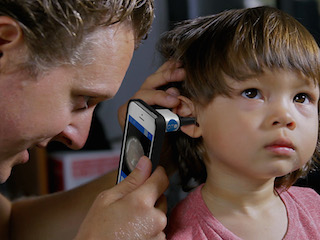 Parents in California who have children who get chronic ear infections will soon have a more convenient way to get their kids care.
Parents in California who have children who get chronic ear infections will soon have a more convenient way to get their kids care.
San Francisco-based CellScope, a Khosla Ventures-backed Rock Health alum, has begun taking preorders for its FDA registered smartphone-enabled otoscope, called Oto Home. The director-to-consumer device is priced at $79 and will ship in four to six weeks. A feature-rich, $299 version of the system, called Oto Pro, is also available for preorder now to physicians located anywhere in the US.
The small smartphone peripheral device slides onto a specialty case that fits iPhone 5 and 5s phones and leverages the devices camera and recording capabilities. After placing one of the company's custom soft tips on the scope (or, if a physician is using it, any otoscope tip they have in the office), the parent or physician uses the companion app to begin recording a session. After inserting the Oto into the child's ear canal, the app's software recognition feature called the Eardrum Finder begins directing them to move and tilt the scope to capture the visuals a physician will need to attempt a diagnosis.
After removing the scope from the child's ear canal, the user ends the recording session and enters in any symptom data, time of last ear infection, and some basic data about the child. The session can then be sent to a remote physician who will review the video and data before placing a phone call to the parent within two hours. If necessary and the physician is comfortable making a diagnosis with the information provided, a prescription can then be sent to the parent's pharmacy of choice.
The preordered devices include one free remote consultation with a physician, the Oto Connect service, but each session costs $49 thereafter. CellScope is starting with California as regulations vary state-to-state for telemedicine services, but it expects to rollout its services to consumers in other states in the future.
"[While there is a physician version of the Oto,] our primary focus is on the consumer market and the Oto Home system," Amy Sheng, the co-founder of CellScope told MobiHealthNews in an interview. "We're focused initially on trying to find parents whose kids get chronic ear infections. There are almost 4.6 million of these 'frequent flier' kids each year in the US. Not surprisingly, those are families who really feel the pain point. As a parent you are constantly taking time off to bring them in."
Sheng said that her company focused on designing the system to be as simple as possible because unlike thermometers, which everybody already has in their homes, otoscopes are not medical devices that people are comfortable using -- yet.
"This is a very new thing," she said. "Parents aren't used to using otoscopes. They've seen their pediatrician using otoscopes with their child, but they never have."
If it succeeds, CellScope's device will be on a fairly short list of medical devices in recent history that made the transition from exclusively being used in clinical settings to finding its way home and into the hands of patients.
The $299 physician version of the system, called the Oto Pro, does not include the Eardrum Finder feature but does include a number of others. The hardware is also a bit more advanced as it includes insufflation capability for pneumatic otoscopy, which physicians can use to help make a diagnosis when a simple visual inspection is not enough. Oto Pro also allows clinicians to store patient data longitudinally, connects with CellScope's HIPAA-compliant storage, and enables clinicians to export a PDF of the session to their EHR system. While CellScope does not provide the necessary bulb for using the insufflator feature, most common insufflator bulbs work with the device, according to the company.
Prior to this week's commercial launch, CellScope had made the first generation of its Oto device available to 800 physicians across the country -- in all 50 states. Its earliest users in that group had used the Oto device in their practices for more than six months. The feedback from this group of beta testers and the company's focus groups with parents led to the company's second iteration of the device, which is what is now available for preorder.

















